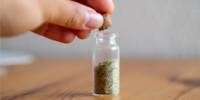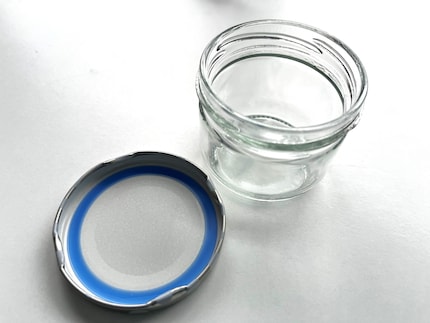
Guide
Herbal salt: the 5-minute gift
by Stefanie Lechthaler

Leftover food shouldn’t be thrown away. So put it in the freezer – and store it properly. Plastic containers, freezer bags, storage jars, aluminium foil and stainless steel boxes are the best ways to freeze food.
If you have leftovers from dinner, it’s a good idea to freeze them for later. Or if you want to be more efficient you might meal prep for days. Therefore it’s important to store the food in a suitable material in the freezer so that when it defrosts it doesn’t get contaminated.
Most households have a drawer full of plastic tubs and/or preserving jars somewhere, be it high-quality plastic boxes, rinsed-out ice cream containers or old pickle jars. If there’s leftover food, in most cases it simply ends up in whatever container that’s big enough before going into the freezer. However you need to bear in mind the material.
What you should avoid at all costs are harmful substances that migrate from the packaging into your food – the technical term for this is chemical migration. Three factors can influence this: the temperature, the food and the contact time and surface area. Ice cream tubs, for example, are designed for one-off cooling, but this doesn’t make them suitable for food that’s served hot. In addition, the combination of fats and plastic isn’t recommended, as this can easily lead to the transfer of unhealthy substances.
When it comes to plastic; recycling old margarine containers, yoghurt pots or ice cream tubs and then freezing greasy soup, pasta bake or other leftovers in them is, unfortunately, a bad idea. These containers are designed for single use under certain conditions. An ice cream tub is designed not to release any chemicals into the ice cream in the freezer compartment. If it’s then filled with warm soup and, in the worst case, cleaned several times in the dishwasher, unhealthy chemicals can easily end up in the food. The risk is particularly high with fatty foods.
High-quality [plastic boxes](/search?filter=t_pt%3D381%2Ct_11247%3D928&q=storage box) and bags that are explicitly designed for freezing are a safer bet. Nevertheless, disposable products such as freezer bags or cling film are best avoided from a sustainability perspective. Even high-quality plastic always carries the risk of plasticisers or other harmful substances dissolving and getting into the food.
With [aluminium foil](/search?q=aluminum foil) you should be aware that it’s unsuitable for acidic foods regardless of the temperature. The acid can cause aluminium ions to dissolve from the foil and pass into the food. Therefore, don’t wrap or cover pickles, tomato sauce or sour fruit in aluminium foil. If you want to make sure that nothing uninvited gets into your food stainless steel is a good choice.
There are screw-top jars everywhere in my kitchen cupboards because I’ve preferred them over plastic jars for a long time now. But I have to admit: I’ve rarely frozen anything in a jar. «Why is that?» I ask myself now. «Because I don’t want broken glass in my freezer!» is the simple answer. When I think of having liquid in jars that are frozen, I involuntarily see a pile of broken glass in food sludge in front of me. After all, liquid expands when it’s cold. But that’s no reason to do without glass when freezing. Simply leave a little space in the glass and the food can expand easily without bursting the jar.
There are good reasons for choosing glass too: you always have glass jars to hand and they’re practically free if you recycle your pickle, jam or other preserving jars instead of throwing them away. The big advantage is that glass doesn’t release any harmful substances into the food – making it a good freezing option for fatty foods.

Finally, the easiest option: you can, of course, simply freeze the leftovers directly in the bowl, plate or pot they’re already in. Use a plate as a lid and pop it on top, then put it in the freezer. Of course, this only works if you can do without the respective piece of crockery until you defrost it again.
How do you freeze your leftovers?
Header image: Anna Sandner
Science editor and biologist. I love animals and am fascinated by plants, their abilities and everything you can do with them. That's why my favourite place is always the outdoors - somewhere in nature, preferably in my wild garden.
Practical solutions for everyday problems with technology, household hacks and much more.
Show all